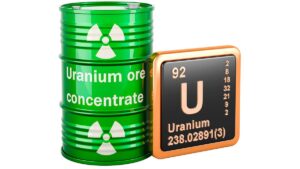Uranium’s next upward move could be ‘particularly strong and chaotic’, experts say

Picture: Getty Images
- The Sprott Physical Uranium Trust (SPUT) could be used to push yellowcake prices sharply higher
- Spot and contract pricing is already edging higher toward incentive pricing of US$60-90/lb
- Bank of America says there are FIVE ways investors can take advantage of this emerging bull market
As quickly mobilised spot volumes become scarce, speculators could use the Sprott Physical Uranium Trust (SPUT) to push yellowcake prices sharply higher, say Leigh Goehring and Adam Rozencwajg.
SPUT was established in 2021 to buy up physical uranium on the spot market and take it out of market circulation.
This uranium will not be on-sold for a quick profit.
Instead, pounds bought from the market by this vehicle will be sequestered for the long term and, crucially, each pound bought by SPUT will be one less pound available for end-users during the next cycle.
It currently has over 61.7 million pounds of U3O8 under lock and key.

New York fund managers Goehring and Rozencwajg track (and own) SPUT as a barometer of uranium investor sentiment.
“When investors are bullish on uranium, the Sprott Uranium Trust often trades at a significant premium to the value of its uranium holdings,” they say.
“At its peak in September 2021, it traded at a 30% premium to NAV [net asset value]. In contrast, when investors turn bearish, the Sprott Uranium Trust can trade at a discount to NAV.”
When SPUT trades at a premium to NAV, it can issue new shares and purchase uranium. When it trades at a discount, this option is not available.
This is where the savvy speculators come in.
‘Unique dynamic’ could cause uranium prices to surge
Financial players will be a huge force in global uranium markets, and SPUT will become their preferred speculative vehicle, Goehring and Rozencwajg say.
“Speculators will eventually realise they can bull the Sprott Physical Uranium Trust, force a premium, have the Trust issue shares, and permanently sequester physical material,” they say.
“Although this strategy would not work in a well-supplied market, it could create sharp price increases when physical material is scarce as utilities are forced to compete with speculators for volumes.
“Uranium is bullish on its own; however, this unique dynamic could cause prices to surge.
“The next upward move in uranium could be particularly strong and chaotic.”
These higher prices are needed to incentivise new production
US$60-90/lb seems to be the new consensus price to incentivise new projects to come online, says Canaccord Genuity following a bunch of panel discussions at the CG Global Metals & Mining conference.
Spot, which is just an indication of term contract pricing (where most uranium production goes), is currently edging higher towards US$60/lb.
Spot #uranium 5550/5650 USc/Lb #U3O8 (Delivery at ALL , Chg +52c, +0.93%) ALL = CVD 0c/Lb, ALL = CMX 0c/Lb See https://t.co/oK6SEbpBZL
— numerco (@numerco) June 7, 2023
Term contracts are already starting to reflect these higher prices, Canaccord says.
“Minimum floor prices have risen to US$48-$50/lb U3O8, and ceilings have moved to US$75-$80/lb, a material increase above the ~US$60/lb ceiling price expected just a year ago,” they say.
“A number of our panelists also suggested that they are not in a rush to commit their pounds right now and would rather hold those pounds or have them 100%-market linked (to spot) to capture potential upside as prices increase over the next couple of years.”
Bank of America (BofA) analysts are also bullish on uranium and nuclear power.
“After a decade of underinvestment, a shortage is visible; our strategists forecast 20-40% upside,” they say in a recent note.
“Global demand is also rising, with 60 new reactors being built & 100 more approved. Resource nationalism, energy security, war and inflation echo the nuclear build-out of the 1970s/80s.
“Our metals analyst, Michael Widmer, forecasts uranium prices of $75/lb by the end of 2025.”
BofA metals strategists believe global mine production will not be able to keep pace with uranium demand and commercial inventories will be needed to plug the gap.
Their forecast implies a production deficit of 60 million pounds in 2035, on par with Kazakhstan’s (15% of global reserves) annual output:

How can punters invest in the ‘3rd bull market for uranium’?
BofA says there are FIVE ways investors can take advantage of this bull market – physical uranium trusts, like SPUT; the explorers and miners; nuclear power component suppliers; nuclear power plants; and uranium ETFs.
When it comes to miners it likes the West’s largest producer Cameco (TSX:CCO), giving it +38% upside.
“Cameco’s contract book reached 215 million pounds of uranium in 1Q23, the strongest it’s been since 2014,” BofA says.
“A growing pipeline of business and competition among utilities to secure long-term contracts should help bolster profitability.
“Cameco’s bid for a 49% stake in Westinghouse is expected to close in 3Q23 and would enhance nuclear exposure.
“Westinghouse just announced the launch of a small nuclear reactor (SMR) called the AP300. The reactor is expected to cost less than $1 billion and should be available by 2027.”
Here’s a bunch of ASX stocks with uranium exposure to run your eye over.
Any missing? Let us know at [email protected].
| CODE | COMPANY | 1 MONTH RETURN % | YTD RETURN % | 12 MONTH RETURN % | PRICE | MARKET CAP |
|---|---|---|---|---|---|---|
| SLX | Silex Systems | 29% | 31% | 179% | 4.2 | $988,780,536 |
| EL8 | Elevate Uranium | 1% | -8% | -30% | 0.34 | $93,668,545 |
| MOM | Moab Minerals | 20% | 33% | -56% | 0.012 | $8,183,563 |
| BSN | Basin Energy | 27% | -7% | -30% | 0.14 | $8,100,000 |
| THR | Thor Energy | 11% | -17% | -62% | 0.005 | $7,300,065 |
| GLA | Gladiator Resources | 0% | -19% | -38% | 0.013 | $7,100,210 |
| ACB | A-Cap Energy | 15% | -23% | -37% | 0.054 | $66,551,496 |
| CXU | Cauldron Energy | 0% | 0% | -46% | 0.007 | $6,520,982 |
| SBR | Sabre Resources | -4% | -42% | -60% | 0.022 | $6,412,697 |
| ARE | Argonaut Resources | -50% | -33% | -60% | 0.001 | $6,361,872 |
| LAM | Laramide Resources | 5% | -8% | -23% | 0.46 | $584,731 |
| DYL | Deep Yellow | 31% | 3% | -3% | 0.72 | $544,121,344 |
| HAR | Haranga Resources | -17% | -17% | -39% | 0.1 | $5,081,403 |
| TOE | Toro Energy | -8% | 22% | -35% | 0.011 | $47,947,765 |
| RIO | Rio Tinto | 2% | -4% | -4% | 111.33 | $41,327,501,106 |
| 92E | 92Energy | 10% | 0% | -23% | 0.43 | $40,318,671 |
| NFL | Norfolk Metals | 15% | 15% | 0% | 0.155 | $4,700,375 |
| UVA | Uvre | 27% | 8% | -30% | 0.14 | $4,577,753 |
| MEU | Marmota | -13% | -31% | -47% | 0.033 | $34,940,420 |
| LOT | Lotus Resources | 5% | -5% | -32% | 0.195 | $262,076,500 |
| PEN | Peninsula Energy | 27% | 46% | 3% | 0.19 | $238,839,502 |
| BMN | Bannerman Energy | 12% | -16% | -30% | 1.515 | $227,271,098 |
| BHP | BHP Group | 0% | -4% | -5% | 44 | $220,869,776,243 |
| OKR | Okapi Resources | -4% | -20% | -54% | 0.12 | $22,210,323 |
| BKY | Berkeley Energia | 26% | 61% | 31% | 0.46 | $205,066,490 |
| EME | Energy Metals | -9% | -23% | -47% | 0.1 | $20,968,332 |
| VAL | Valor Resources | 25% | -23% | -38% | 0.005 | $19,015,175 |
| ADD | Adavale Resource | 47% | 47% | -3% | 0.028 | $14,027,662 |
| GTR | Gti Energy | 0% | -35% | -53% | 0.007 | $13,634,280 |
| DEV | Devex Resources | 13% | 21% | 1% | 0.34 | $126,064,717 |
| AGE | Alligator Energy | 12% | -5% | -46% | 0.037 | $122,268,379 |
| KNG | Kingsland Minerals | 116% | 167% | 0% | 0.4 | $12,575,938 |
| 1AE | Aurora Energy Metals | -23% | -51% | -70% | 0.074 | $11,722,114 |
| AEE | Aura Energy | 3% | -27% | -14% | 0.185 | $105,609,089 |
| NXG | Nexgen Energy Canada | 20% | 0% | 3% | 6.675 | $103,162,733 |
| PDN | Paladin Energy | 2% | -7% | -13% | 0.65 | $1,937,095,192 |
| BOE | Boss Energy | 22% | 47% | 39% | 3.14 | $1,089,468,685 |
Related Topics

UNLOCK INSIGHTS
Discover the untold stories of emerging ASX stocks.
Daily news and expert analysis, it's free to subscribe.
By proceeding, you confirm you understand that we handle personal information in accordance with our Privacy Policy.








